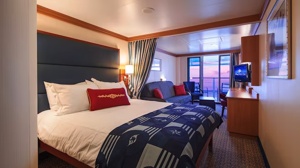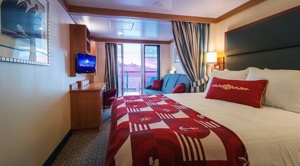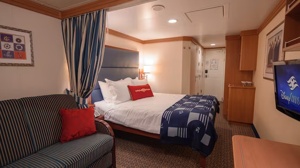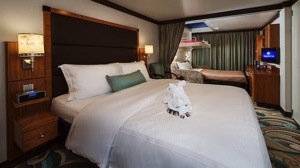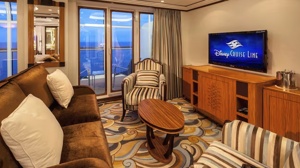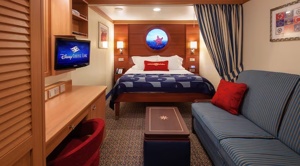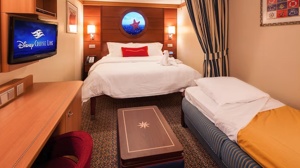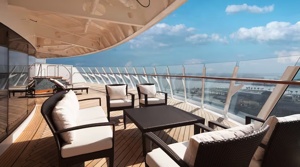Enjoy the most square footage of any stateroom type, combined with exclusive and attentive concierge services. Concierge Family Oceanview Staterooms with Verandah are classified as Category 03A and are located on Decks 11 and 12, Forward.
Relax in private quarters fitted with warm wood finishes, custom fabrics and carpeting, original artwork, crown moldings, genuine teak accents and a private verandah for magnificent views of the sea.
Specifications
- Sleeps: 5
- Size: 306 sq. ft., including verandah
- Room Configuration: queen bed, double sleeper sofa and upper berth pull-down bed
- View: private verandah with floor-to-ceiling windows
Amenities
- Custom Premium Plush Euro-top mattress
- Frette® 300-thread-count, 100% cotton linens
- Premium Frette® bath towels
- 22" LCD flat-screen TV on swivel arm, with remote control
- Full-length mirror
- Ample closet space
- Refrigerator
- In-room safe
- Hair dryer
- Phone with voicemail messaging
- Individual climate control
- Elemis® Body Exotics bath, shower and spa products
Upgraded Amenities
While all Disney Cruise Line staterooms feature luxury amenities and world-class service, Guests of our Concierge Suites and Staterooms enjoy an expanded range of offerings:
- Down Duvets: Enjoy a superlative night's sleep with the softness of genuine feather duvets, featured in Concierge main bedrooms.
- Guests of our Concierge Suites may choose from pillow options including hypoallergenic, feather and therapeutic memory foam.
- Personal Robe and Slippers: These plush comforts are yours to use for the duration of your cruise.
- Complimentary 24-Hour Wi-Fi Internet Service: Enjoy Basic Surf Wi-Fi for each Guest in the stateroom at no extra charge. (Usage fees apply after the 24-hour package expires.)
Design
Disney Cruise Line has thought of everything to ensure first-rate comfort and convenience during your voyage. Concierge Family Oceanview Stateroom with Verandah design features include:
- A sitting area with a couch, TV and desk
- A heavy privacy curtain to separate the sitting and sleeping areas
- A “split bath”: a bathroom with a vanity, sink, shower and round tub and a half bathroom with a vanity, sink and toilet
- Elevated wooden bed frames for under-bed storage of suitcases and other large items
- A leather-upholstered ottoman with hollow inside storage
- Attractive yet functional cabinetry in the living area
Verandah
Airy and private, this sanctuary is where you can watch the sun rise, bask in ocean breezes and enjoy your morning coffee or an evening nightcap.
Your private balcony comes equipped with:
- Patio furniture
- Deck lighting
- Plexiglas® or solid whitewall railings
- Childproof locks
Expanded Main Suite Option
For large parties, add an adjoining Concierge 1-Bedroom Suite with Verandah or Concierge Royal Suite with Verandah. On adjoining accommodations, the partition between verandahs can be opened to create a larger balcony for sharing, with access between rooms.
Pre-Arrival Services
Our signature Concierge services begin before you board the ship and continue throughout your vacation and beyond. Pre-reserve many of your onboard activities and services online, up to 120 days prior to your sail date. You may also inform the Concierge Team of your preferences 130 days prior to sailing, and they will make the bookings on your behalf when the 120-day booking window opens. Requests will be processed in the order in which they are received.
A dedicated Concierge Agent is available Monday through Saturday, 8:30 AM to 5:30 PM. Call (866) 784-1654 for personalized assistance in planning every cruise detail, including:
- Port Adventures
- Reservations for Palo or Remy, spa treatments or nursery stays
- Dining room seating requests
- Special occasions and celebrations
- Any other special requests, from pre-arrival to post-cruise
Please note that requests are confirmed at time of booking and cannot be guaranteed. Guests under 18 years of age must have parent or guardian permission to call this number. All experiences are subject to availability and may be subject to capacity restraints.
Shipboard Services
During your cruise, the benefits of signature Concierge service begin with priority check-in and boarding at a dedicated check-in station. Our onboard Concierge team will meet you at a private welcome reception—exclusive to Concierge Guests—and will be available to attend to your needs, questions and special requests. Enjoy assistance with:
- Reservations (Port Adventures, Palo and Remy dining, spa treatments and nursery stays)
- Dining reservation confirmations and changes
- Priority tendering in ports of call
- Updates to your personal itinerary
- Special occasions and celebration planning
Exclusively for Concierge Guests
As a Concierge Guest, you'll enjoy exclusive access to dedicated areas on the ship, including the Concierge Lounge. Located amid the Concierge Suites on Deck 12, this stylish, modern retreat allows Guests to relax in quiet comfort, sip a cocktail (during select hours), access the Internet (fees may apply), watch news on a large-screen TV, and enjoy complimentary food and nonalcoholic beverages offered throughout the day.
From the Lounge, Concierge Guests can access a sun deck via a private entrance. Soak up the sun at this VIP onboard oasis and savor tranquil breezes, cooling water misters, cushioned lounge chairs, and a bar stocked with water and refreshments.
Facilities
- Queen or Twin Configuration
- Sofa Bed
- Pullman Bed
- Lounge Area
- Vanity Area
- Shower
- Room Service Available
- TV
- Free Wi-Fi
- Safe
- Hair Dryer
- Telephone
- Desk
- Exclusive
- Air Conditioning



